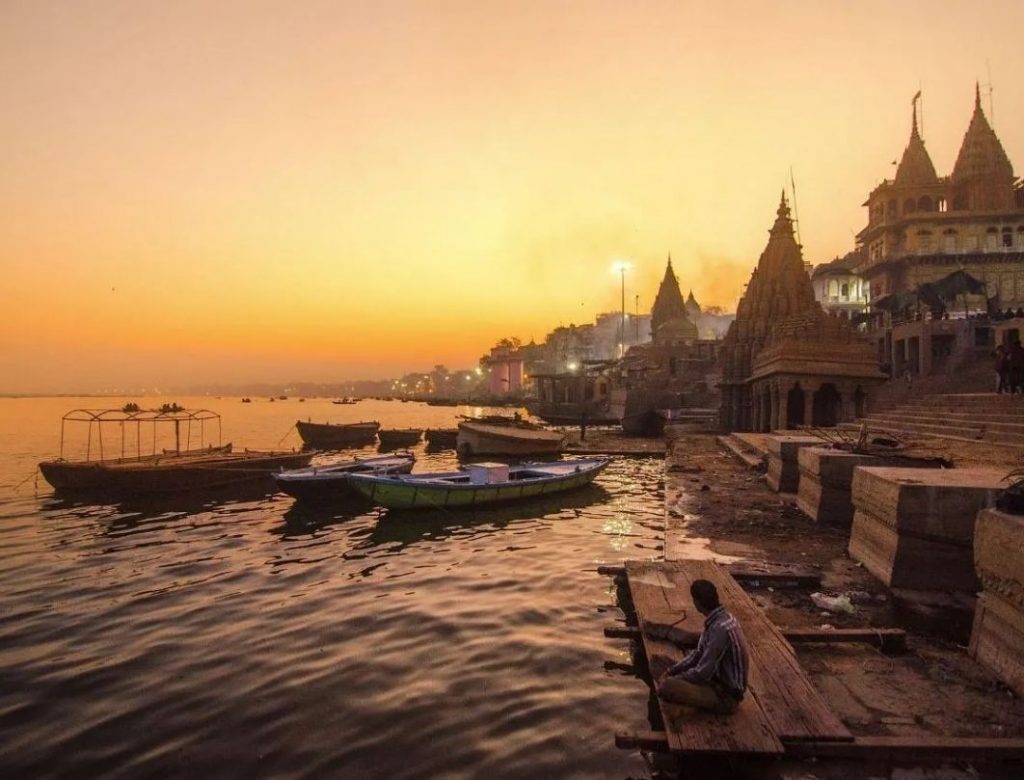Varanasi Walking Tour Guide

Varanasi Walking Tour Guide
There are cities, and then there is Varanasi—India’s oldest living city, where every stone whispers a sacred story. But if you really want to feel the pulse of Kashi, you won’t find it behind a car window. You’ll find it in the labyrinthine alleys, the chants echoing from temple courtyards, the scent of incense trailing from doorways, and the sudden burst of life at a ghat you never knew existed.
A Varanasi walking tour is not just sightseeing—it’s soul-searching with your shoes on. This guide, curated by Tripcosmos.co, will help you uncover the real essence of Varanasi—step by sacred step.
1. Introduction – Why Walk Varanasi?
Walking as a Gateway to Spiritual Discovery
In Varanasi, the divine isn’t confined to temples—it flows through the air, the water, and most definitely, the streets. Walking allows you to feel the ancient rhythms, pause where others rush, and absorb the spiritual texture of everyday life.
Whether it’s a flower-seller preparing marigold garlands or a pandit blessing a newborn at a street shrine, walking keeps you close to the sacred and the simple.
What Makes a Varanasi Walking Tour Unique
Unlike guided bus or cycle rickshaw tours, walking lets you:
- Navigate lanes too narrow for vehicles
- Discover hidden ghats and backdoor temples
- Engage with locals and hear their stories
- Stop for a chai break, a pooja, or a quick blessing
Tripcosmos.co walking tours are led by local experts who live and breathe Banaras, offering spiritual insights, historical context, and practical tips along the way.
2. What to Expect on a Varanasi Walking Tour
The Sights, Sounds, and Smells of the Spiritual Capital
From sunrise to sunset, the streets of Varanasi are a symphony of senses:
- The clink of brass bells as temples open
- The fragrance of incense and street food
- The sight of holy men, pilgrims, and cows sharing space
- The chants and conch-shell calls rising from every corner
Be ready to be overwhelmed, surprised, and deeply moved. Every few steps, you’ll stumble upon a scene out of a scripture or a folk tale.
How Walking Connects You with Local Life
On foot, you’re not a tourist—you’re a participant. You’ll meet:
- Weavers crafting Banarasi silk in family-run workshops
- Priests offering Ganga jal to temple visitors
- Tea stall owners eager to chat about Shiva and cricket
- Kids playing cricket in courtyards that date back 800 years
Tripcosmos.co’s routes are designed for authentic cultural encounters, not just photo ops.
3. Best Time to Take a Varanasi Heritage Walk
Seasonal and Daily Timing Tips
Varanasi can be intense—hot in summer, foggy in winter. The best times for walking are:
- October to March: Cool, pleasant, perfect for long walks
- April to June: Early mornings or post-sunset walks only
- Monsoon (July to September): Great for romantic walks, but be cautious on slippery steps
Daily ideal hours:
- Sunrise (5:00–7:30 AM): Best light, least crowd
- Late afternoon (4:00–6:00 PM): Temples reopen, street life picks up
- Evening (after 7:00 PM): Great for ghats and aarti-focused walks
Tripcosmos.co adjusts walk timings daily to match sunrise, rituals, and crowd patterns for the best experience.
Avoiding the Crowds for an Authentic Experience
Want to avoid the crowds? Opt for lesser-known trails, weekday mornings, and routes away from Dashashwamedh Ghat. Our guides at Tripcosmos.co know the sweet spots for serenity even in this bustling city.
4. Popular Walking Routes in Varanasi
Ghats Walk – Dashashwamedh to Assi Ghat
This route hugs the Ganges and takes you past:
- Dashashwamedh Ghat: Site of the famous Ganga Aarti
- Manikarnika Ghat: The eternal cremation ground
- Harishchandra Ghat: Another ancient cremation site
- Assi Ghat: Home of Subah-e-Banaras and student spirituality
Ideal for first-timers and spiritual explorers.
Temple Trail – Vishwanath Gali and Hidden Shrines
Wind through sacred alleys filled with:
- Small Shiva shrines
- Annapurna Devi Temple
- Hidden Hanuman temples
- Vishalakshi Shaktipeeth—a lesser-known power spot
Tripcosmos.co guides explain mythology, architecture, and rituals at each stop.
Food and Culture Walk – The Culinary Lanes of Kachori Gali
Perfect for foodies and culture buffs. Includes:
- Kachori-Sabzi at iconic stalls
- Banarasi Lassi from century-old shops
- Chaat, rabri, and malaiyyo tasting
- Insights into Banarasi wedding and music traditions
Heritage Walk – From Chowk to Manikarnika Ghat
Explore the oldest part of Kashi, dotted with:
- Ancient havelis
- Mughal-era archways
- Artisan workshops
- Gyanvapi mosque and temple ruins
Tripcosmos.co heritage walks include stories you won’t find in guidebooks.
5. Discovering the Ghats on Foot
Morning Aartis, Sacred Rituals, and River Vibes
The ghats are Varanasi’s beating heart, especially at dawn:
- Priests performing aarti to the rising sun
- Pilgrims bathing in the Ganga
- Locals doing yoga, singing bhajans, and lighting diyas
A slow walk here connects you to life, death, and the divine, all in one frame.
Architectural Marvels and Spiritual Energy
Look out for:
- Ghats built by kings and saints from all over India
- Intricate steps, shrines, and murals
- Temples rising directly from the river
With a Tripcosmos.co guide, you won’t just walk the ghats—you’ll understand their soul.
Continuing with the next insightful sections of the article.
6. Exploring Varanasi’s Hidden Temples and Shrines
Off-the-Map Sacred Spots Only Locals Know
Beyond the grand temples and famous ghats lies a network of secret sanctuaries tucked into the folds of Varanasi’s alleys. You’ll stumble upon shrines that don’t appear on any tourist map—tiny Shiva lingas under Peepal trees, Hanuman idols set into walls, and Goddess Durga altars protected by iron grills.
These hidden gems are alive with local faith. Vendors leave morning offerings before opening shop. Children touch the idols before heading to school. Every shrine tells a quiet story of daily devotion.
Tripcosmos.co guides take you on a devotion trail, explaining the relevance and legends behind each lesser-known deity you encounter.
The Power of Small Altars and Personal Devotion
In Varanasi, faith isn’t just about the big temples—it lives in every nook. A simple diya flickering before a modest idol can carry as much reverence as the main sanctum of a grand temple.
This kind of walking exploration opens your eyes to how personal and intimate Indian spirituality really is, and why Varanasi is considered the city of inner discovery.
7. Varanasi Heritage Walk – Stories in Every Brick
Ancient Havelis, Markets, and Mughal Architecture
Step into the Chowk area, and you’re stepping back centuries. The narrow lanes here are flanked by carved wooden balconies, fading murals, and brass-studded doorways. Some of these havelis have housed poets, saints, and royal families over generations.
You’ll see:
- Historic mansions of silk traders and musicians
- Traditional spice and bangle markets
- The Akharas (wrestling schools) where locals still train at dawn
- Traces of Mughal influence in arches, window grills, and courtyards
Tripcosmos.co connects these visuals with stories of Varanasi’s transformation through the eras—from the Puranic age to British rule.
Walking Through Varanasi’s Historic Timeline
Every 10 steps, the scenery changes—from medieval to colonial to modern. Our guides take you on a narrative time travel, highlighting:
- The lanes where Tulsidas composed Ramcharitmanas
- Courtyards where Kabir’s verses were sung
- The haveli that inspired a Tagore poem
It’s not just about history—it’s about walking through a timeline with your own feet.
8. Food, Flavors, and Street Bites During the Tour
Must-Try Delicacies Like Kachori, Lassi, and Tamatar Chaat
No Varanasi walk is complete without a few mouthfuls of local heaven. As you wind through the alleys, you’ll be tempted by:
- Kachori Sabzi: Crisp on the outside, spicy and soulful inside
- Tamatar Chaat: A fiery, tangy explosion of flavor unique to Varanasi
- Malaiyyo (in winter): A frothy, cloud-like dessert made only before 8 AM
- Banarasi Lassi: Thick, creamy, and topped with saffron and nuts
Tripcosmos.co includes hygiene-tested food stops in its Food+Heritage Walk combo, perfect for safe culinary indulgence.
Sweet Stops and Breakfast Add-ons
Enjoy:
- Jalebi with Rabri: A sweet-savory morning ritual
- Paan from iconic shops known to have served royalty and film stars
- Optional rooftop breakfast after the walk, overlooking the Ganga
Let your tastebuds walk with you—it’s part of the experience!
9. Booking a Varanasi Walking Tour with Tripcosmos.co
Why Go With a Local Expert
While it’s tempting to explore solo, Varanasi’s layered chaos can be overwhelming. Our Tripcosmos.co guides are not just navigators—they’re storytellers, mythologists, and locals who bring emotion and insight to every step.
Benefits of booking with Tripcosmos.co:
- Local guides fluent in English, Hindi, and regional languages
- Routes customized for spiritual, historical, or food-focused travelers
- Affordable prices, no hidden fees
- Group or private tours, tailored to your pace and interests
Customized Routes and Special Themes
Whether you’re:
- A first-time traveler
- A returning pilgrim
- A documentary filmmaker
- A photographer
- A seeker on a solo trip
…we have a walking tour just for you.
Tripcosmos.co also offers women-only heritage walks, senior citizen-friendly tours, and themed spiritual walks during festivals.
10. What to Wear and Carry for a Walking Tour
Dress Code for Temples and Comfort Essentials
While there’s no strict dress code for the streets, modest clothing is appreciated:
- Full-length pants or salwars
- Loose-fitting, breathable tops or kurtas
- A scarf or shawl (for temples and sudden chill)
- Hat or cap + sunscreen for daytime walks
Comfort is key—you’ll be walking 2 to 4 km over uneven paths, so dress accordingly.
Daypacks, Footwear, and Local Etiquette
What to bring:
- A small backpack for water, wallet, and camera
- Closed, cushioned shoes or trekking sandals
- Hand sanitizer and wet wipes
- An open mind and a quiet respect for sacred spaces
Tripcosmos.co provides refreshment packs, prayer kits, and reusable water bottles with every walking tour.
Continuing with the final informative sections of the article…
11. Language and Interaction Tips
Learning a Few Local Phrases
While most Varanasi locals understand basic English, a few Hindi phrases can go a long way toward making connections and receiving warm smiles. Here are a few handy ones:
- Namaste / Pranam – A respectful greeting
- Har Har Mahadev! – A spiritual greeting and mantra of Lord Shiva
- Dhanyavaad – Thank you
- Yeh mandir kahan hai? – Where is this temple?
- Bahut sundar hai – Very beautiful
Tripcosmos.co guides are happy to translate, teach basic phrases, and help you converse with locals during your walk.
How to Engage Respectfully with Locals
- Always ask before taking photos, especially of people praying or doing rituals.
- Remove footwear when stepping into temple courtyards or shrines, even if they’re tiny.
- Avoid public arguments or debates near religious areas—respect the peace.
- A polite smile or a nod is often the best way to acknowledge someone’s space.
Walking through Varanasi’s alleys is like entering someone’s sacred home—observe, absorb, and act mindfully.
12. Photography Tips for the Walking Tour
Best Angles, Lighting, and Candid Moments
Varanasi is a photographer’s dream, with textures, expressions, colors, and drama at every corner. Here’s how to make the most of it:
- Golden hour (sunrise to 8 AM) is perfect for temple light and shadow play.
- Shoot in alleyways with leading lines and contrasting colors.
- Capture devotional moments, street portraits, chai stalls, and the chaos of ghats.
- Don’t forget the doorways and old signage that tell a tale of time.
Tripcosmos.co guides can help position you for the best compositions, even assisting with mobile photography techniques.
What Not to Photograph in Sacred Spaces
- Manikarnika and Harishchandra Ghats: Avoid shooting cremations unless permitted.
- Inside small temples: Most allow only darshan, not photography.
- Prayers and private rituals: Be discreet and respectful.
- Children and women at water: Always seek permission.
If in doubt, ask your guide. Respect over the perfect shot—that’s the spirit of sacred travel.
13. Varanasi Walking Tours During Festivals
Dev Deepawali, Holi, and Makar Sankranti
During festivals, the streets of Varanasi transform into living theatre. Walking through them gives you front-row access to the magic.
- Dev Deepawali: Diyas light every ghat, music and dance fill the air
- Holi: The narrow lanes become rivers of color and song
- Makar Sankranti: Kite-filled skies and ghat rituals of sun worship
Tripcosmos.co offers special festival-themed walking tours with cultural insights, pooja participation, and VIP river cruise combinations.
How the City Transforms for Each Occasion
- Crowds swell, but so does the energy
- The streets glow with light, color, and devotion
- Temporary shrines, stages, and processions enrich your walking journey
You’ll see Varanasi at its most vibrant and chaotic—and most divine.
14. Safety Tips for a Hassle-Free Walk
- Walk in single file in narrow lanes to avoid blocking locals
- Stick with your group and stay aware of your guide’s location
- Watch for cows, scooters, and sudden turns—Varanasi is wonderfully unpredictable
Tripcosmos.co guides are trained in crowd navigation and emergency handling, ensuring you’re never left behind or disoriented.
Staying Aware While Immersing Fully
- Don’t carry large amounts of cash or flashy jewelry
- Keep phones and wallets secure in zippered compartments
- Trust your instincts—if a space feels too crowded or tense, step aside
- Always follow your guide’s advice in spiritual or sensitive zones
We ensure your experience is immersive, enlightening, and safe.
15. Conclusion – Let Varanasi’s Streets Lead You to the Divine
A Varanasi walking tour is not just a journey through space—it’s a step back in time, a plunge into faith, and a conversation with the cosmos. With every twist in the alley and every turn of the ghat, Varanasi whispers her secrets. But only if you slow down, walk, and listen.
With Tripcosmos.co, you walk with locals, with legends, and with layers of understanding that make your experience personal and powerful. So lace up, show up, and let the streets of Kashi lead you to your own divine discovery.
FAQs
1. How long is a typical Varanasi walking tour?
Most tours range from 2 to 3 hours, depending on the route and number of stops.
2. Is a guide necessary for Varanasi walks?
Highly recommended. The alleys are complex, and local guides from Tripcosmos.co offer deep spiritual and historical context.
3. Can I do the Ghats walk in the evening?
Yes. Evening walks combined with the Ganga Aarti and temple visits are popular and breathtaking.
4. Are walking tours safe for solo female travelers?
Absolutely. Tripcosmos.co offers women-guided walks, safe group options, and assistance for solo travelers.
5. What is the best walking route for first-time visitors?
The Ghats walk and Temple Trail offer a perfect blend of spirituality, architecture, and local interaction.




